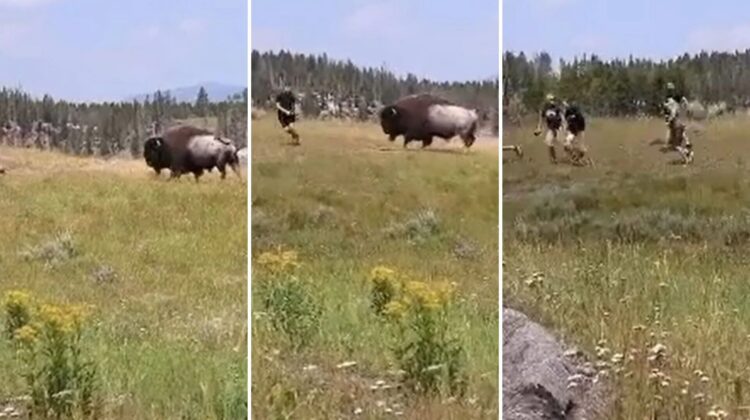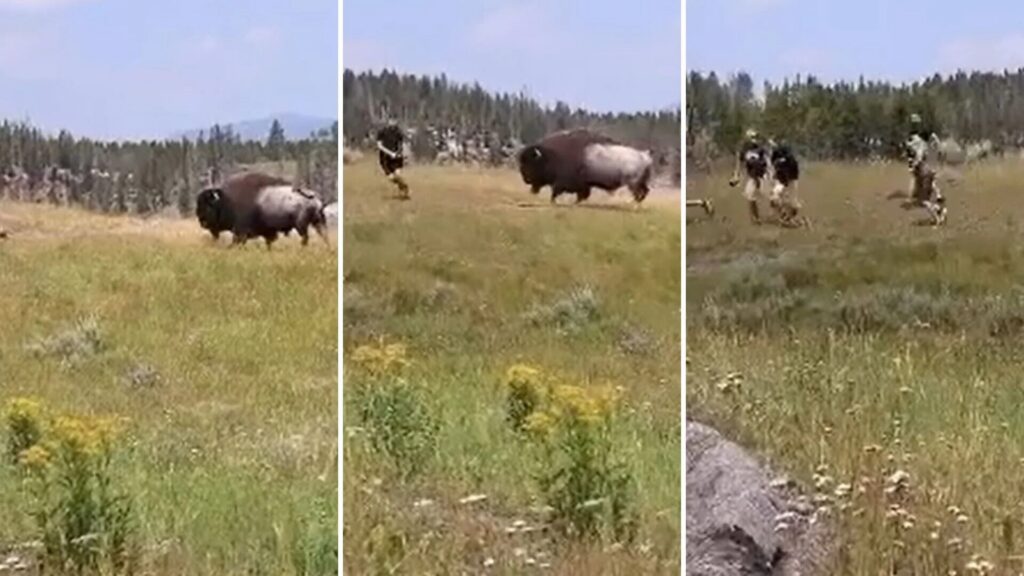
In the age of smartphones and social media, it seems that the line between curiosity and recklessness is growing thinner. A recent bystander video captured a heart-stopping moment at Yellowstone National Park, highlighting the perilous actions of some visitors and the potential danger they pose to themselves and the park’s iconic inhabitants.
Bison, those magnificent creatures that roam Yellowstone’s vast landscapes, are a marvel of nature. Faster and more agile than even world-class athletes, they can charge at speeds of up to 40 miles per hour, leap six feet into the air, and change direction with astonishing swiftness. Yet, despite these awe-inspiring abilities, approaching a bison is never a good idea – a lesson some visitors to the park seem determined to learn the hard way.

In a troubling social media post, shared by the account ‘Tourons of Yellowstone’ (@touronsofyellowstone) on Instagram, a short video from September 11 shows a group of what they’ve aptly dubbed “tourons” – a blend of “tourist” and “moron” – getting dangerously close to a bison in Yellowstone National Park. As the massive creature nonchalantly takes a few threatening steps towards them, the tourists scatter in a panic.
The National Park Service (NPS) has clear guidelines in place, advising people to maintain a distance of at least 25 yards from bison and elk and a whopping 100 yards from bears and wolves within the park. Unfortunately, as the video demonstrates, these guidelines are often ignored.
Commenters on the social media post expressed their outrage at the blatant disregard for the safety of both visitors and animals. One commenter aptly pointed out, “The harassment of these animals is so wrong and is a more critical issue to address than any focus on protecting selfish humans.” Others echoed the sentiment that if such misbehavior continues, the park may eventually have to close its doors to visitors.
In this particular incident, the group of tourists was fortunate. The bison chose to bluff a charge rather than follow through, but their slow retreat could easily have led to severe injury or even death. It’s a grim fact that bison have injured more people in Yellowstone than any other animal.
The NPS emphasizes that it’s essential to give these animals space, whether near campsites, trails, boardwalks, parking lots, or developed areas. Visitors should be prepared to change direction and move away if necessary to avoid getting too close. Approaching a bison can trigger a range of defensive behaviors, including bluff charges, head bobbing, pawing, bellowing, or snorting – all clear signs that you are too close and that a charge is imminent.
What makes encounters with bison even more perilous is their unpredictability. In the video, the bison displayed none of these warning signs, illustrating just how challenging it can be to gauge their reactions accurately.

Despite the risks they pose, bison play a crucial role in biodiversity conservation. A 2002 study analyzing over 30 years of data revealed that reintroducing these magnificent animals to tallgrass prairies more than doubled plant diversity and richness. Each time a video like this gains traction on social media, it prompts renewed calls for greater protection of the park’s iconic wildlife.
As one commenter passionately put it, “I want to see them all immediately hauled to jail,” calling for hefty fines and lifetime bans for those who put these magnificent creatures and themselves at risk. Another commenter summed up the sentiment, saying, “These videos make me lose hope in the human race.”
In the end, Yellowstone’s breathtaking beauty and its awe-inspiring inhabitants deserve our utmost respect and protection. It’s crucial that visitors to this national treasure remember that they are guests in the wild home of these magnificent animals and act accordingly, ensuring that both they and the wildlife can continue to coexist safely.

Leave a Reply